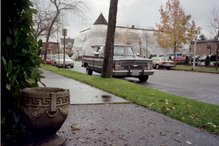Fire Sale (G.P. Putnam's Sons, New York: 2005) is set in South Chicago, where the narrator, private detective V.I. Warshawski was a child. "In this town, your childhood home dogs you your whole life."(Page 8). As an amplification of the priority we need to make about being aware of where objects come from, the novel is set in a small flag factory, and characters in the novel reflect the hardships and dangers of people at work to craft the flags, symbols of the United States.
One motivator for me to read Fire Sale was the Bysen family characters, who own BySmart and are modeled after people who own Walmart. Presently in the news in Walmart's Food Deserts: Greening the Bottom Line by Eric Holt Gimenez: First Lady Michelle Obama announced that SUPERVALU, Walgreens and Walmart committed to open or expand 1,500 supermarkets across America's food deserts -- low-income areas without easy access to a supermarket. Gimenez concludes - if greening the food deserts are a policy priority, then we need more than just new supermarkets. We need programs that reduce record high income inequality and create jobs with decent living wages.
One motivator for me to read Sara Paretsky's Fire Sale was the current primary election voter's pamphlet. A section about the Pierce County Citizenship Celebration illustrates "We're bringing back an old tradition," with photographs of flags from 1941's "I am an American Day."
"The soft fabric was falling from her machine into a wooden box: the U.S. flag must not touch the ground." (Page 112) The factory's worker's daughters are on the basketball team narrator private detective Warshawski has volunteered to coach, and concerned about how meager the funding is for the girls' positive involvement and activity, she approaches the Bysen (BySmart) family with a request for support. The factory worker feeds six people on her small salary. A theme of the novel is teen pregnanacy. The girls sleep in flag sheets. The story centers around an explosion and fire at the factory, which becomes an even more grim place just after the fire: "...still some bolts of fabric in their plastic sheathing,...the edges had been eaten by rodents, charmed to have such soft nest-building material laid out for them." (Page 370).
Some chapter titles refer to cowboy songs, "Home, Home on the Range", for example, as a reference to the homonym Byson and Bison.


No comments:
Post a Comment